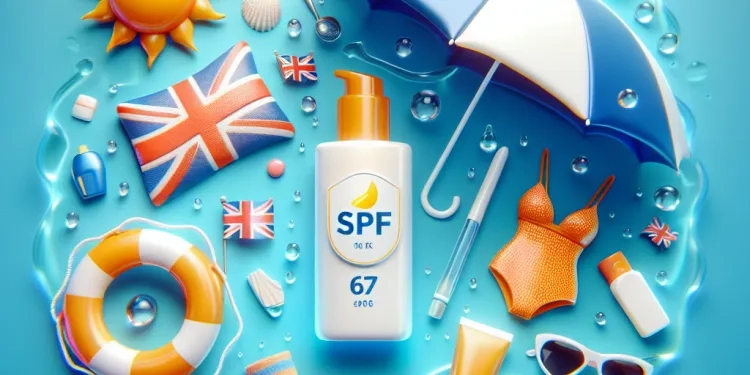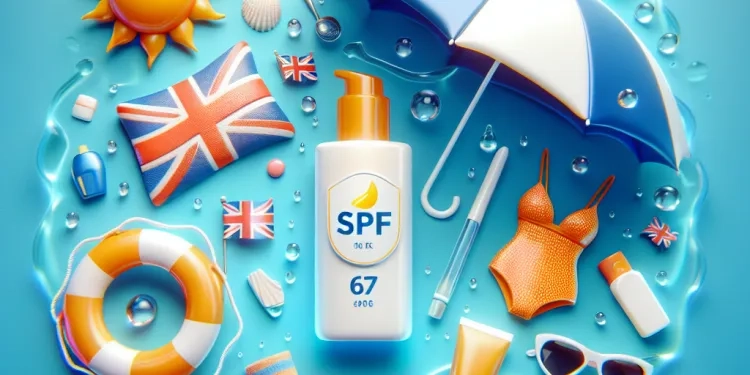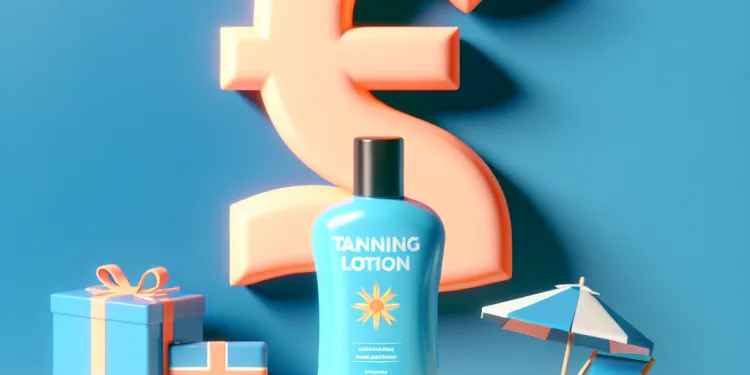
Find Help
More Items From Ergsy search
-

Do I need a different SPF for water-related activities?
Relevance: 100%
-

How does sunscreen with SPF 20 compare to SPF 50?
Relevance: 42%
-

Is a higher SPF always better?
Relevance: 39%
-

What does SPF stand for?
Relevance: 38%
-

What SPF level is recommended to prevent sunburn?
Relevance: 38%
-

Can makeup with SPF replace sunscreen?
Relevance: 37%
-

What SPF should I use if I am going to be outdoors all day?
Relevance: 37%
-

Should I use a different SPF for my face and body?
Relevance: 34%
-

What SPF should I use if I have sensitive skin?
Relevance: 34%
-

What SPF is best for children?
Relevance: 29%
-

Which factor sunscreen should I use?
Relevance: 28%
-

Is SPF 15 enough for everyday use?
Relevance: 27%
-

The Benefits of Family Activities
Relevance: 24%
-

When are mosquitoes most active in the UK?
Relevance: 23%
-

Are activities provided for residents in care homes?
Relevance: 22%
-

What is the active ingredient in Mounjaro?
Relevance: 21%
-

What is the active ingredient in Wegovy?
Relevance: 21%
-

How important is physical activity in preventing obesity?
Relevance: 21%
-

Can SEND children access extracurricular activities?
Relevance: 20%
-

Staying Active: National Health Campaigns Promoting Physical Well-being
Relevance: 19%
-

When is it safe to return to normal activities after a concussion?
Relevance: 19%
-

How can I check recent login activity on my email account?
Relevance: 19%
-

Do homeopathic medicines contain any active ingredients?
Relevance: 19%
-

Does tanning lotion prevent sunburn?
Relevance: 18%
-

When is it safe to return to normal activities after a concussion?
Relevance: 18%
-

How important is physical activity for older adults picking new hobbies?
Relevance: 18%
-

How can I check recent login activity on my social media accounts?
Relevance: 18%
-

Why are there login attempts from unfamiliar locations in my email activity?
Relevance: 17%
-

NHS Pensions | How to Claim? | Ill Health, Active & Deferred Members
Relevance: 17%
-

What SPF is recommended for fair skin?
Relevance: 16%
-

Can I work or continue sports activities if I have Carpal Tunnel Syndrome?
Relevance: 16%
-

What activities should I avoid during a heatwave?
Relevance: 16%
-

Will I be able to return to normal activities after hip replacement?
Relevance: 16%
-

How do I choose the right SPF for daily use?
Relevance: 15%
-

Can you participate in sports or physical activities with a stoma bag?
Relevance: 15%
-

How often should I reapply sunscreen?
Relevance: 14%
-

When is West Nile Virus most active?
Relevance: 14%
-

What SPF should I use if I have darker skin?
Relevance: 14%
-

How can I be sure that my sunscreen SPF rating is accurate?
Relevance: 14%
-

Do I need sunscreen on cloudy days?
Relevance: 13%
The Importance of SPF in Water-Related Activities
When partaking in water-related activities, protecting your skin from the sun's harmful rays is crucial. Ultraviolet (UV) radiation can cause sunburn, skin damage, and increase the risk of skin cancer. In water, UV rays can penetrate deeper due to reflection off the water surface, making it important to choose the right Sun Protection Factor (SPF).
What Does SPF Mean?
SPF stands for Sun Protection Factor, a measure of how well a sunscreen protects the skin from UVB rays, which are the main cause of sunburn. For everyday use, dermatologists generally recommend a broad-spectrum sunscreen with an SPF of at least 30. However, for water-related activities, factors such as water resistance, duration of exposure, and intensity of sunlight should be considered.
Choosing the Right SPF for Water Activities
For those engaging in water-related activities, it's advisable to use a water-resistant sunscreen with a higher SPF. Water-resistant sunscreens are effective for up to 40 or 80 minutes, depending on the formulation. This means that even though you are in water, you can rely on the sunscreen protection as long as it is reapplied as advised.
In the UK, the weather can sometimes be unpredictable, but UV rays can penetrate clouds, making SPF important on overcast as well as sunny days. An SPF of at least 50 is recommended for prolonged periods in the water or intense midday sun exposure to ensure adequate protection.
Reapplication is Key
When you're swimming, splashing, or sweating, even the best SPF can wear off. Reapplying sunscreen every two hours or immediately after swimming, towel drying, or excessive sweating is crucial. Look for products specifically labeled as water-resistant and remember water resistance does not equate to waterproof.
Conclusion: Considerations for UK Water Enthusiasts
In selecting the correct SPF for water-related activities, consider water resistance and SPF level. Choose a broad-spectrum sunscreen to shield against both UVA and UVB rays. With the UK's varied weather, being protected even on cloudy days is important. Always carry a bottle of sunscreen and reapply as necessary to stay protected while enjoying water activities.
The Importance of SPF in Water-Related Activities
If you play in the water, it is very important to protect your skin from the sun. The sun can burn your skin and make it hurt. This can also cause skin problems later on. The sun's rays are stronger in the water because they bounce off the water's surface. So, you need to choose the right sunscreen with SPF to protect you.
What Does SPF Mean?
SPF means Sun Protection Factor. SPF tells how well sunscreen stops the sun from burning your skin. Doctors suggest using sunscreen with SPF 30 or more for every day. But, if you are in the water, you need to think about how long you will stay and how strong the sun is.
Choosing the Right SPF for Water Activities
If you play in the water, pick a sunscreen that does not wash off easily. These are called water-resistant sunscreens. Some work for 40 minutes, and others for 80 minutes. Always put it on again to make sure you are safe from the sun.
Even if it is cloudy in the UK, the sun can still harm your skin. Always use sunscreen. Choose SPF 50 if you stay in the water for a long time or if the sun is very strong in the middle of the day.
Reapplication is Key
When you swim or sweat, sunscreen can stop working. Put on more sunscreen every two hours. You should also do this after you swim or dry off with a towel. Make sure the sunscreen says it is water-resistant, but remember it is not waterproof.
Conclusion: Considerations for UK Water Enthusiasts
To choose the best sunscreen, look for water resistance and the right SPF. Sun protection should cover both UVA and UVB rays. Even on cloudy days in the UK, use sunscreen. Always have a bottle with you and put it on again to stay safe while having fun in the water.
Frequently Asked Questions
What does SPF stand for?
SPF stands for Sun Protection Factor, which measures the level of protection a sunscreen offers against UVB rays.
Why do I need a different SPF for water activities?
Water activities can wash off sunscreen, reducing its effectiveness. A water-resistant SPF is recommended for better protection.
What is water-resistant sunscreen?
Water-resistant sunscreen is formulated to remain effective for a certain period even when exposed to water or sweat.
How long does water-resistant sunscreen last?
Water-resistant sunscreens typically provide protection for 40 to 80 minutes in water. Always check the label for specific duration.
Is regular SPF ineffective in water?
Regular SPF may wash off more easily and provide less protection during water activities compared to water-resistant formulas.
Do I need to reapply sunscreen more often when swimming?
Yes, it is important to reapply water-resistant sunscreen every 40 to 80 minutes or immediately after towel drying or excessive sweating.
Can I use the same sunscreen for the beach and the pool?
Yes, as long as it is water-resistant and offers broad-spectrum protection, it can be used in both environments.
Does water affect the SPF level of sunscreen?
Water can decrease the effectiveness of non-water-resistant sunscreens but does not change the SPF level of water-resistant ones.
What SPF level is recommended for water activities?
An SPF of 30 or higher is recommended for prolonged outdoor activities, including water-related ones.
Can children use water-resistant sunscreen?
Yes, water-resistant sunscreen is suitable for children, but ensure it is formulated for their sensitive skin and offers high SPF protection.
How can I tell if sunscreen is water-resistant?
The sunscreen label will indicate if it is water-resistant and specify the duration of water resistance, such as 40 or 80 minutes.
Do water-resistant sunscreens also protect from UVA rays?
Check for 'broad-spectrum' protection on the label to ensure it protects against both UVA and UVB rays.
Is there a difference between water-resistant and waterproof sunscreen?
The term 'waterproof' is no longer allowed by the FDA. Sunscreens can only be labeled as 'water-resistant.'
Can I use the same sunscreen for surfing and running?
A water-resistant, broad-spectrum sunscreen can be used for both water and land activities if it remains effective during sweating.
Can makeup with SPF be used in water?
Most makeup with SPF is not water-resistant. Use a separate water-resistant sunscreen for water activities.
Do I need different sunscreen for pools vs. natural bodies of water?
No, a water-resistant sunscreen will work for both; however, consider using reef-safe products in natural environments.
Are spray sunscreens effective for water activities?
Yes, but ensure even application and rub it in after spraying to cover all areas.
Is higher SPF better for water activities?
Higher SPF can offer more protection, but reapplication of a water-resistant, broad-spectrum sunscreen is crucial.
How should I apply water-resistant sunscreen?
Apply generously 15 minutes before water exposure and reapply every 2 hours or after swimming or sweating.
Can I rely on SPF clothing instead of sunscreen in water?
SPF clothing provides good protection, but uncovered areas should still be protected with water-resistant sunscreen.
What does SPF mean?
SPF stands for "Sun Protection Factor."
SPF is a number. It tells you how well sunscreen protects your skin from the sun's rays.
If you want to learn more about SPF, you can use pictures or videos. This can make it easier to understand.
SPF means Sun Protection Factor. It tells you how well sunscreen can protect your skin from the sun's UVB rays.
Why Do I Need Special Sun Cream for Water Fun?
When you play in the water, the sun can still burn your skin. Use a special sun cream for water fun. This keeps your skin safe.
Helpful Tip: Look for sun cream that says 'waterproof' or 'water-resistant.'
Remember: Always reapply sun cream after swimming.
When you play in water, sunscreen can come off. This makes it not work as well. It is a good idea to use sunscreen that says "water-resistant" on the bottle. It will protect you better.
What is water-resistant sunscreen?
Water-resistant sunscreen is a cream or spray that helps keep your skin safe from the sun. It stays on your skin even when you swim or sweat.
Here is how to use it:
- Put it on your skin before going outside.
- Reapply it after swimming or sweating.
You can ask an adult to help you if you need it. Using a waterproof timer can remind you when to put more on.
Water-resistant sunscreen keeps working when you get wet or sweat. But it only lasts for a little while.
How long does water-resistant sunscreen last?
Water-resistant sunscreen stays on your skin for a short time when you get wet or sweat.
- It can last for about 40 to 80 minutes in water.
- After that, you need to put more on.
Tip: Use a timer to remind you when to put on more sunscreen.
When you use water-resistant sunscreen, it keeps you safe in the water for about 40 to 80 minutes. Look at the label to see how long it lasts.
Does sunscreen stop working in water?
Normal sunscreen can wash off quickly and might not protect you well when you're in water. Water-resistant sunscreen stays on better when you're swimming or playing in water.
Do I need to put on more sunscreen when I swim?
Yes, you should put on more sunscreen when you swim. Water can wash away sunscreen. Try using sunscreen that is water-resistant. Remember to take a break, dry off, and put on more sunscreen every time you get out of the water.
Yes, it is important to put on more water-resistant sunscreen every 40 to 80 minutes. Do it right away after you use a towel to dry off or if you sweat a lot.
Can I use the same sunscreen for the beach and the pool?
Yes, you can use the same sunscreen for both the beach and the pool. Look for a sunscreen that says "water-resistant" on the bottle. This means it works well near water.
Here are some tips:
- Put on sunscreen before you go outside.
- Put on more sunscreen every couple of hours or after you swim.
- Ask an adult to help if you need it.
Yes, you can use it in both places if it keeps water out and protects you from the sun.
Does water change how well sunscreen works?
Water can make some sunscreens not work as well. But if a sunscreen says it is water-resistant, water does not change how strong it is.
What sunscreen number is best for swimming?
If you go swimming, use sunscreen with SPF 30 or higher. SPF is a number that shows how strong the sunscreen is. Higher SPF means more protection from the sun.
Try these tips to remember:
- Look for water-resistant sunscreen. It stays on better in water.
- Put on sunscreen 15 minutes before you swim.
- Ask an adult to help you if you need it.
Use sunscreen every time you swim to keep your skin safe from the sun.
When you go outside for a long time, like playing or swimming, use sunscreen. Choose one with SPF 30 or higher. This will help protect your skin from the sun.
Can kids use sunscreen that does not wash off in water?
Yes, you can use water-resistant sunscreen for kids. Make sure it is made for their soft skin and has high protection from the sun.
How do I know if sunscreen can stay on in water?
Look at the label on the bottle. It might say "water-resistant." This means it won't come off quickly in water.
If you are going to swim or get wet, use sunscreen that says "water-resistant."
You can set a timer to remind you when to put on more sunscreen after being in water. This helps keep your skin safe.
The sunscreen bottle will say if it can stay on in water. It will also tell you how long it works in water, like 40 or 80 minutes.
Do Water-Resistant Sunscreens Stop UVA Rays?
Some sunscreens keep working when you swim or sweat. These are called water-resistant. But do they stop UVA rays?
UVA rays from the sun can hurt your skin. So, look for sunscreen that says "broad-spectrum." This means it helps stop both UVA and UVB rays.
Use sunscreen with SPF 30 or higher for good protection. Try using a timer to remember when to reapply sunscreen, especially after swimming.
Look for 'broad-spectrum' on the bottle. This means it will protect your skin from both UVA and UVB rays.
Is there a difference between water-resistant and waterproof sunscreen?
Yes, there is a difference.
Water-resistant sunscreen means it will stay on your skin for a while in water or when you sweat. But you will still need to put it on again after swimming or drying with a towel.
Waterproof sunscreen means it is very strong in water and will last longer. But it is important to know that no sunscreen is fully waterproof. You should always reapply it after swimming or sweating.
Tip: Use a timer to remind you when to put on more sunscreen, or ask someone to help you remember.
The name 'waterproof' is not allowed anymore. Sunscreens can only say 'water-resistant' on the label. This is a rule from the FDA, which is a group that makes sure products are safe.
Can I use the same sunscreen for surfing and running?
Do you want to know if you can use the same sunscreen for surfing and running?
Here is how you can think about it:
- Water: If you are surfing, you need sunscreen that works in water.
- Sweat: If you are running, you need sunscreen that works when you sweat.
Some sunscreens can do both. Look for "waterproof" or "sweatproof" on the bottle.
For help, ask an adult or use a phone app to read sunscreen labels.
You can use a special sunscreen that works well in water and on land. This sunscreen doesn't stop working even if you sweat.
Can you wear makeup with SPF in water?
Makeup with SPF might not work well in water.
Use waterproof makeup with SPF to help protect your skin in water.
You can also put on sunscreen before your makeup for extra protection.
Remember to reapply sunscreen often if you are in the water for a long time.
Most makeup with sunscreen is not good in water. Use another sunscreen that works well in water for swimming or playing in water.
Do I Need Different Sunscreen for Swimming Pools and Lakes or the Ocean?
When you swim, it is important to protect your skin from the sun. But do you need different sunscreen for a swimming pool and a lake or the ocean?
Supportive Tip: Try using sunscreen that is "water-resistant." This will work well in both places.
No, you do not need different sunscreens. A water-resistant sunscreen is good for both water and land.
But, if you go near a reef, use reef-safe sunscreen. This helps protect nature.
Do spray sunscreens work when swimming or in water?
Spray sunscreens can help protect your skin in the water. But make sure you put on enough spray and rub it in well.
These tips can help:
- Spray a lot on your skin.
- Rub the sunscreen in after spraying.
- Put it on 15 minutes before you go in the water.
- Use sunscreen again every 2 hours or after swimming.
Stay safe in the sun by wearing a hat and staying in the shade too!
Yes, you can do it. Make sure to spread it evenly. After you spray, rub it in to cover everywhere.
Is a higher SPF better for swimming and playing in water?
A sunscreen with a higher SPF number gives you more protection from the sun. But it is very important to put sunscreen on again, especially if you use one that stays on in water and protects from both sunburn and skin damage.
How do I use sunscreen that stays on in water?
Put on a lot of sunscreen 15 minutes before you go in the water. Put on more every 2 hours or after you swim or sweat.
Can I use clothes with SPF instead of sunscreen in water?
Clothes with SPF can help protect your skin from the sun. These clothes have a special coating to keep the sun away.
But, if you go into water, sunscreen is still important. Water can make SPF clothes less strong.
Use sunscreen with your SPF clothes for better protection.
Ask someone to help you put sunscreen on hard-to-reach places. It’s okay to ask for help!
SPF clothes help keep you safe from the sun. But you still need to put sunscreen on any skin that is showing. Make sure the sunscreen is water-resistant.
Useful Links
- Ergsy carfully checks the information in the videos we provide here.
- Videos shown by Youtube after a video has completed, have NOT been reviewed by ERGSY.
- To view, click the arrow in centre of video.
- Most of the videos you find here will have subtitles and/or closed captions available.
- You may need to turn these on, and choose your preferred language.
- Go to the video you'd like to watch.
- If closed captions (CC) are available, settings will be visible on the bottom right of the video player.
- To turn on Captions, click settings .
- To turn off Captions, click settings again.
More Items From Ergsy search
-

Do I need a different SPF for water-related activities?
Relevance: 100%
-

How does sunscreen with SPF 20 compare to SPF 50?
Relevance: 42%
-

Is a higher SPF always better?
Relevance: 39%
-

What does SPF stand for?
Relevance: 38%
-

What SPF level is recommended to prevent sunburn?
Relevance: 38%
-

Can makeup with SPF replace sunscreen?
Relevance: 37%
-

What SPF should I use if I am going to be outdoors all day?
Relevance: 37%
-

Should I use a different SPF for my face and body?
Relevance: 34%
-

What SPF should I use if I have sensitive skin?
Relevance: 34%
-

What SPF is best for children?
Relevance: 29%
-

Which factor sunscreen should I use?
Relevance: 28%
-

Is SPF 15 enough for everyday use?
Relevance: 27%
-

The Benefits of Family Activities
Relevance: 24%
-

When are mosquitoes most active in the UK?
Relevance: 23%
-

Are activities provided for residents in care homes?
Relevance: 22%
-

What is the active ingredient in Mounjaro?
Relevance: 21%
-

What is the active ingredient in Wegovy?
Relevance: 21%
-

How important is physical activity in preventing obesity?
Relevance: 21%
-

Can SEND children access extracurricular activities?
Relevance: 20%
-

Staying Active: National Health Campaigns Promoting Physical Well-being
Relevance: 19%
-

When is it safe to return to normal activities after a concussion?
Relevance: 19%
-

How can I check recent login activity on my email account?
Relevance: 19%
-

Do homeopathic medicines contain any active ingredients?
Relevance: 19%
-

Does tanning lotion prevent sunburn?
Relevance: 18%
-

When is it safe to return to normal activities after a concussion?
Relevance: 18%
-

How important is physical activity for older adults picking new hobbies?
Relevance: 18%
-

How can I check recent login activity on my social media accounts?
Relevance: 18%
-

Why are there login attempts from unfamiliar locations in my email activity?
Relevance: 17%
-

NHS Pensions | How to Claim? | Ill Health, Active & Deferred Members
Relevance: 17%
-

What SPF is recommended for fair skin?
Relevance: 16%
-

Can I work or continue sports activities if I have Carpal Tunnel Syndrome?
Relevance: 16%
-

What activities should I avoid during a heatwave?
Relevance: 16%
-

Will I be able to return to normal activities after hip replacement?
Relevance: 16%
-

How do I choose the right SPF for daily use?
Relevance: 15%
-

Can you participate in sports or physical activities with a stoma bag?
Relevance: 15%
-

How often should I reapply sunscreen?
Relevance: 14%
-

When is West Nile Virus most active?
Relevance: 14%
-

What SPF should I use if I have darker skin?
Relevance: 14%
-

How can I be sure that my sunscreen SPF rating is accurate?
Relevance: 14%
-

Do I need sunscreen on cloudy days?
Relevance: 13%